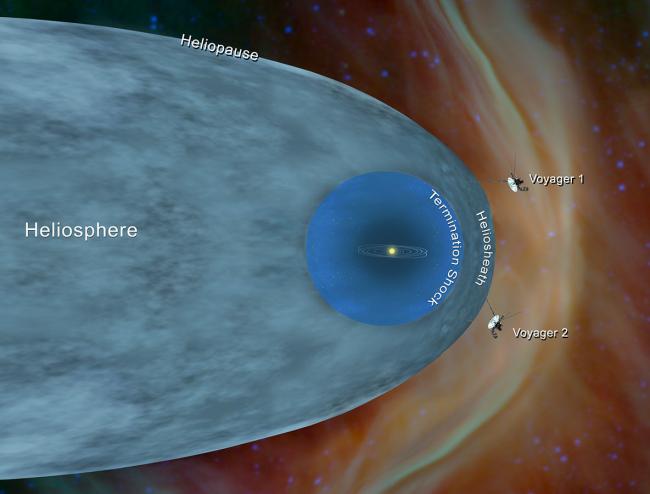
A schematic of the solar system showing the heliosphere and the locations of the Voyager 1 and 2 spacecraft. Astronomers used to think that the heliosphere was cometary in shape, but a new model finds, in agreement with observations by spacecraft, that it is more nearly spherical than previously thought because of the role played by neutral atoms that become ionized and then influenced by magentic fields.
The heliosphere is the bubble-like cavity around the Sun, created by the solar wind, that extends well beyond Pluto until the pressure of the interstellar medium ultimately terminates it. For decades astronomers thought that the heliosphere had a roughly cometary shape, spherical with a long tail, shaped by a combination of the solar wind, the interstellar medium, and the Sun's motion through the galaxy. The Voyager 1 and 2 missions, both launched in 1977, have since traversed the heliosphere and crossed its edge (the heliopause) into the interstellar medium; Voyager 1 did so in 2012 and Voyager 2 in 2018. Along the way they measured many properties of the heliosphere, and forced astronomers to conclude that the solar magnetic field, previously neglected, plays a crucial role in shaping the heliosphere and that its shape is not really cometary. The Cassini mission, launched in 1997 to explore Saturn, also found evidence that there is no tail to the heliosphere. The question has now become what the shape of the heliosphere really is and how it is determined.
CfA astronomers Merav Opher and Avi Loeb and two of their colleagues tackled these issues with detailed modeling of the heliosphere that is unique in that included as a separate component the pick-up ions in the wind. These ions are originally neutral atoms in the solar wind that become ionized when they become excited by ultraviolet radiation or by collisions and then can respond to magnetic effects. The New Horizons mission to Pluto recently made the first direct detection of pick-up ions in the solar wind; it measured them as far away from the Sun as thirty AU (one AU is the average distance of the Earth from the Sun, and Pluto’s average distance from the Sun is about forty AU). Voyager found that near the shocked edge of the heliopause, the heliosheath, the pressure of these ions actually dominated the pressure.
The astronomers ran several sets of calculations of the heliosphere in order to account for the relatively unconstrained parameters of the magnetic field’s strength and direction, and took into account the production and depletion of pick-up ions. They find that when the ions encounter neutral hydrogen they become neutral, cool, and deflate, making the heliosheath smaller and rounder, in agreement with the Cassini observations. The new model reproduces the behaviors of both the pick-up ions and the solar wind ions and matches the observations made by all the spacecraft. The model does not include effects of the solar cycle variations, however, but future model improvements will do so, and together with new measurements should be able to refine our understanding of the Sun's heliosphere.
Reference(s):
"A Small and Round Heliosphere Suggested by Magnetohydrodynamic Modelling of Pick-up Ions," Merav Opher, Abraham Loeb, James Drake, and Gabor Toth, Nature Astronomy 4, 675, 2020.